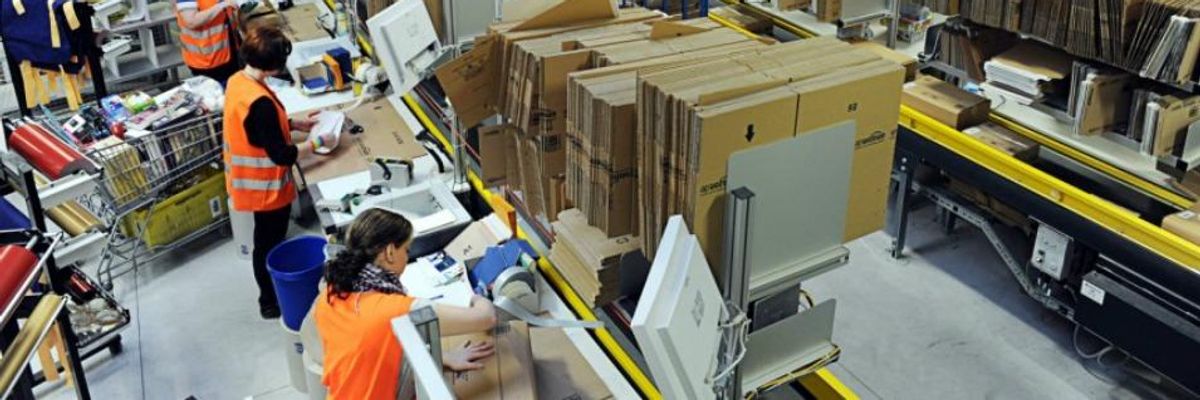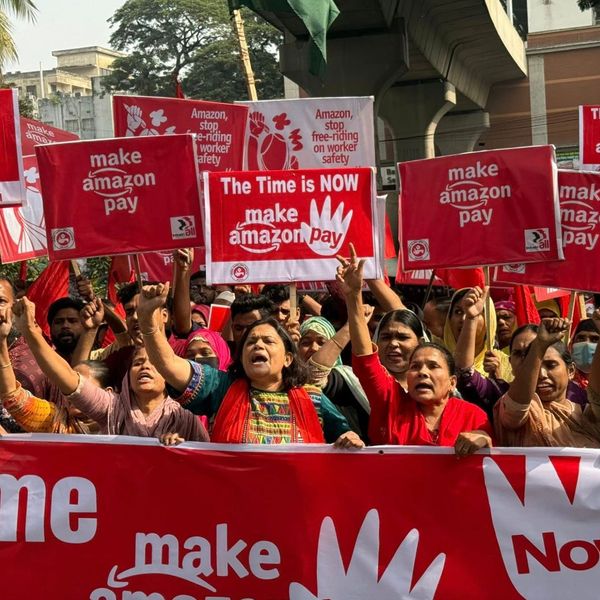
Amazon recently secured patents for wristbands that could monitor where a worker's hand goes. The bands are apparently meant to be used to increase productivity, potentially in the company's warehouses. (Photo: Scott Lewis/Flickr/cc)
With Latest Dystopian Step, Amazon Sparks Worries With Patent on Worker-Tracking Wristband
Patent designs detail how wristbands would vibrate if wearer moves hand "incorrectly" when completing warehouse work
Privacy advocates and labor groups raised concern Thursday over retail giant Amazon's newly-secured patents for a wristband that could be worn by warehouse employees, keeping track of where workers hands go while they're packing delivery boxes.
In the latest productivity-minded move by a company that's notorious for enacting stringent policies to ensure that workers meet targets, Amazon's designs outline a wristband that would vibrate when the wearer's hand moved incorrectly.
\u201cThis is frightening: "What if your employer made you wear a wristband that tracked your every move, and that even nudged you via vibrations when it judged that you were doing something wrong?" https://t.co/sU2wur59E3 .@nytimes #FutureOfWork\u201d— UFCW (@UFCW) 1517511819
According to patent documents, obtained by GeekWire, the bracelet could be used to direct a worker to the correct inventory while packing products into delivery boxes:
Existing approaches for keeping track of where inventory items are stored...may require the inventory system worker to perform time consuming acts beyond placing the inventory item into an inventory bin and retrieving the inventory item from the inventory bid... Accordingly, improved approaches for keeping track of where an inventory item is stored are of interest.
Amazon has not announced plans to introduce the wristbands in warehouses at this point, but the news of the patents comes after several other measures the company has taken to track its employees.
In order to hit targets for packaging and delivering orders, warehouse workers are reportedly subjected to timed bathroom breaks and electronic timers to monitor how many boxes they pack per hour during their 55-hour workweeks.
"Amazon's new idea goes to extremes to treat workers like robots... Meanwhile, CEO Jeff Bezos is the richest person on the planet."--Ben Norton, journalist
In 2016, a BBC study also found that delivery workers were routinely speeding and falling asleep at the wheel in order to meet delivery goals.
Critics argue that by introducing the wristbands in its warehouses, Amazon would be forcing employees to work as dexterous robots the company doesn't yet have.
"For Amazon, I believe technologies like this are largely a stop-gap measure until robots can take over more of the work. Currently, workers need to do the picking of packages because the robots don't yet have the necessary dexterity," Martin Ford, author of Rise of the Robots: Technology and the Threat of a Jobless Future, told the New York Daily News.
On Twitter, a number of critics slammed the patents and raised concerns about Amazon's surveillance of its employees.
\u201cAmazon's new idea goes to extremes to treat workers like robots. It was just granted two patents for employee wristbands that track where a warehouse worker's hands are at all times.\n\nMeanwhile, Amazon CEO Jeff Bezos is the richest person on the planet.\nhttps://t.co/FiO36AETfG\u201d— Ben Norton (@Ben Norton) 1480402027
\u201cThere is no technological advancement that employers don't weaponize against workers. \n\nhttps://t.co/vywSSbXEQy\u201d— Erik Loomis (@Erik Loomis) 1517464897
\u201cYour workers are not cattle, @amazon. https://t.co/ayQdw1CCzL\u201d— Emma Vigeland (@Emma Vigeland) 1517515419
\u201cA #futureofwork conversation about the expanding role of digital workplace surveillance is overdue \n\nAmazon patents wristband that tracks warehouse workers' movements\nhttps://t.co/idDa6ljUuT\u201d— Devin Fidler (@Devin Fidler) 1517513923
An Urgent Message From Our Co-Founder
Dear Common Dreams reader, The U.S. is on a fast track to authoritarianism like nothing I've ever seen. Meanwhile, corporate news outlets are utterly capitulating to Trump, twisting their coverage to avoid drawing his ire while lining up to stuff cash in his pockets. That's why I believe that Common Dreams is doing the best and most consequential reporting that we've ever done. Our small but mighty team is a progressive reporting powerhouse, covering the news every day that the corporate media never will. Our mission has always been simple: To inform. To inspire. And to ignite change for the common good. Now here's the key piece that I want all our readers to understand: None of this would be possible without your financial support. That's not just some fundraising cliche. It's the absolute and literal truth. We don't accept corporate advertising and never will. We don't have a paywall because we don't think people should be blocked from critical news based on their ability to pay. Everything we do is funded by the donations of readers like you. Will you donate now to help power the nonprofit, independent reporting of Common Dreams? Thank you for being a vital member of our community. Together, we can keep independent journalism alive when it’s needed most. - Craig Brown, Co-founder |
Privacy advocates and labor groups raised concern Thursday over retail giant Amazon's newly-secured patents for a wristband that could be worn by warehouse employees, keeping track of where workers hands go while they're packing delivery boxes.
In the latest productivity-minded move by a company that's notorious for enacting stringent policies to ensure that workers meet targets, Amazon's designs outline a wristband that would vibrate when the wearer's hand moved incorrectly.
\u201cThis is frightening: "What if your employer made you wear a wristband that tracked your every move, and that even nudged you via vibrations when it judged that you were doing something wrong?" https://t.co/sU2wur59E3 .@nytimes #FutureOfWork\u201d— UFCW (@UFCW) 1517511819
According to patent documents, obtained by GeekWire, the bracelet could be used to direct a worker to the correct inventory while packing products into delivery boxes:
Existing approaches for keeping track of where inventory items are stored...may require the inventory system worker to perform time consuming acts beyond placing the inventory item into an inventory bin and retrieving the inventory item from the inventory bid... Accordingly, improved approaches for keeping track of where an inventory item is stored are of interest.
Amazon has not announced plans to introduce the wristbands in warehouses at this point, but the news of the patents comes after several other measures the company has taken to track its employees.
In order to hit targets for packaging and delivering orders, warehouse workers are reportedly subjected to timed bathroom breaks and electronic timers to monitor how many boxes they pack per hour during their 55-hour workweeks.
"Amazon's new idea goes to extremes to treat workers like robots... Meanwhile, CEO Jeff Bezos is the richest person on the planet."--Ben Norton, journalist
In 2016, a BBC study also found that delivery workers were routinely speeding and falling asleep at the wheel in order to meet delivery goals.
Critics argue that by introducing the wristbands in its warehouses, Amazon would be forcing employees to work as dexterous robots the company doesn't yet have.
"For Amazon, I believe technologies like this are largely a stop-gap measure until robots can take over more of the work. Currently, workers need to do the picking of packages because the robots don't yet have the necessary dexterity," Martin Ford, author of Rise of the Robots: Technology and the Threat of a Jobless Future, told the New York Daily News.
On Twitter, a number of critics slammed the patents and raised concerns about Amazon's surveillance of its employees.
\u201cAmazon's new idea goes to extremes to treat workers like robots. It was just granted two patents for employee wristbands that track where a warehouse worker's hands are at all times.\n\nMeanwhile, Amazon CEO Jeff Bezos is the richest person on the planet.\nhttps://t.co/FiO36AETfG\u201d— Ben Norton (@Ben Norton) 1480402027
\u201cThere is no technological advancement that employers don't weaponize against workers. \n\nhttps://t.co/vywSSbXEQy\u201d— Erik Loomis (@Erik Loomis) 1517464897
\u201cYour workers are not cattle, @amazon. https://t.co/ayQdw1CCzL\u201d— Emma Vigeland (@Emma Vigeland) 1517515419
\u201cA #futureofwork conversation about the expanding role of digital workplace surveillance is overdue \n\nAmazon patents wristband that tracks warehouse workers' movements\nhttps://t.co/idDa6ljUuT\u201d— Devin Fidler (@Devin Fidler) 1517513923
Privacy advocates and labor groups raised concern Thursday over retail giant Amazon's newly-secured patents for a wristband that could be worn by warehouse employees, keeping track of where workers hands go while they're packing delivery boxes.
In the latest productivity-minded move by a company that's notorious for enacting stringent policies to ensure that workers meet targets, Amazon's designs outline a wristband that would vibrate when the wearer's hand moved incorrectly.
\u201cThis is frightening: "What if your employer made you wear a wristband that tracked your every move, and that even nudged you via vibrations when it judged that you were doing something wrong?" https://t.co/sU2wur59E3 .@nytimes #FutureOfWork\u201d— UFCW (@UFCW) 1517511819
According to patent documents, obtained by GeekWire, the bracelet could be used to direct a worker to the correct inventory while packing products into delivery boxes:
Existing approaches for keeping track of where inventory items are stored...may require the inventory system worker to perform time consuming acts beyond placing the inventory item into an inventory bin and retrieving the inventory item from the inventory bid... Accordingly, improved approaches for keeping track of where an inventory item is stored are of interest.
Amazon has not announced plans to introduce the wristbands in warehouses at this point, but the news of the patents comes after several other measures the company has taken to track its employees.
In order to hit targets for packaging and delivering orders, warehouse workers are reportedly subjected to timed bathroom breaks and electronic timers to monitor how many boxes they pack per hour during their 55-hour workweeks.
"Amazon's new idea goes to extremes to treat workers like robots... Meanwhile, CEO Jeff Bezos is the richest person on the planet."--Ben Norton, journalist
In 2016, a BBC study also found that delivery workers were routinely speeding and falling asleep at the wheel in order to meet delivery goals.
Critics argue that by introducing the wristbands in its warehouses, Amazon would be forcing employees to work as dexterous robots the company doesn't yet have.
"For Amazon, I believe technologies like this are largely a stop-gap measure until robots can take over more of the work. Currently, workers need to do the picking of packages because the robots don't yet have the necessary dexterity," Martin Ford, author of Rise of the Robots: Technology and the Threat of a Jobless Future, told the New York Daily News.
On Twitter, a number of critics slammed the patents and raised concerns about Amazon's surveillance of its employees.
\u201cAmazon's new idea goes to extremes to treat workers like robots. It was just granted two patents for employee wristbands that track where a warehouse worker's hands are at all times.\n\nMeanwhile, Amazon CEO Jeff Bezos is the richest person on the planet.\nhttps://t.co/FiO36AETfG\u201d— Ben Norton (@Ben Norton) 1480402027
\u201cThere is no technological advancement that employers don't weaponize against workers. \n\nhttps://t.co/vywSSbXEQy\u201d— Erik Loomis (@Erik Loomis) 1517464897
\u201cYour workers are not cattle, @amazon. https://t.co/ayQdw1CCzL\u201d— Emma Vigeland (@Emma Vigeland) 1517515419
\u201cA #futureofwork conversation about the expanding role of digital workplace surveillance is overdue \n\nAmazon patents wristband that tracks warehouse workers' movements\nhttps://t.co/idDa6ljUuT\u201d— Devin Fidler (@Devin Fidler) 1517513923

